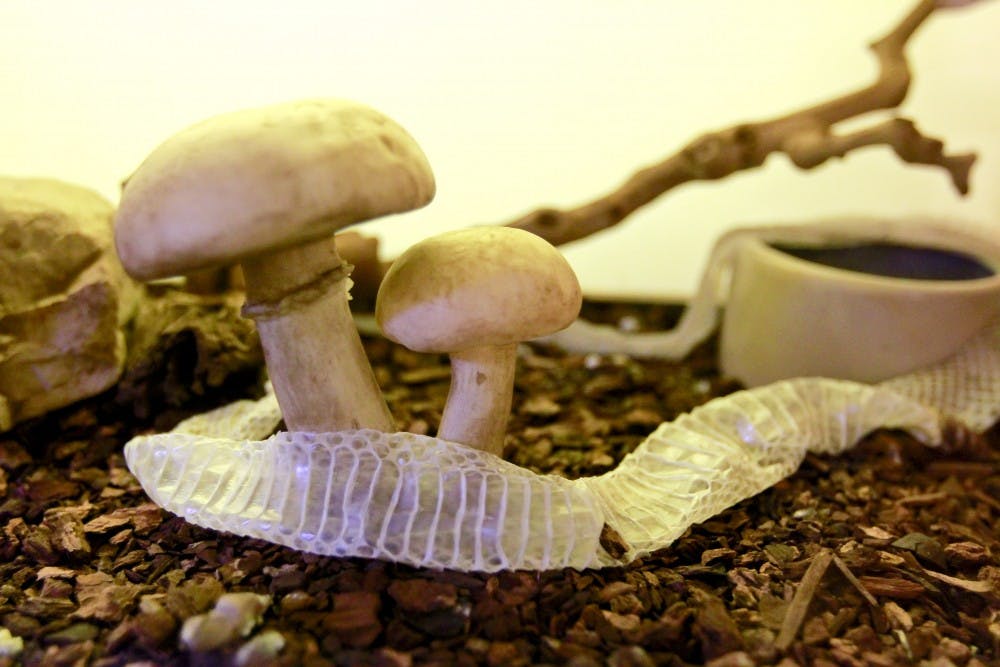culture@dailylobo.com
Neglected, abused and unwanted rattlesnakes from across the country have found a home at the American International Rattlesnake Museum, nestled among the historic adobe buildings of Old Town.
Museum Director Bob Myers said the 75 rattlesnakes housed at the museum — as well as a smattering of tarantulas, tortoises, Gila monsters and scorpions — have come from zoos, animal-testing studies at universities, private breeders and homes that the pets outgrew.
“Some people get them in the pet shop and they’re small, but when they get this big, people are freaking out, they don’t have a lot of room,” Myers said, gesturing at a group of turtles. “Some of them can get so big that they’ll destroy your house, but people don’t think about that ahead of time.”
Some of the 200 to 250 reptiles that annually pass through the museum are found in New Mexico backyards, but others are shipped all the way from Germany or other foreign countries.
“Typically they’re shipped in a wooden crate with either another smaller wooden box inside or a Styrofoam insert that helps keep the temperature from going up and down too fast,” Myers said.
“Those packages usually state, ‘Keep from heat and cold,’ ‘live animals,’ that kind of thing. They’re shipped pretty much like dogs and cats are.”
Only certain airlines, such as Delta, will ship venomous animals that can’t be sent through the mail.
Most of the animals in the museum are venomous, but Myers said nobody has been bitten in the museum since its inception in 1990. The snakes are transferred between cages with hooks and are only handled when they need medical attention.
“We’re real cautious, we work in pairs and at the end of the night we check each other’s work, check locks, check closures, make sure everything’s in place before we leave,” Myers said.
Myers has only been bitten by a rattlesnake once, while handling snakes for a photo shoot for National Geographic, but he said people rarely die from the bites. But he said a negative perception of snakes is still dominant, and he hopes his museum can counter that.
“People always leave feeling better about reptiles,” Myers said. “It’s good for the snakes. A lot of the people who come here with the attitude ‘The only good snake is a dead snake’ might leave with a new respect and understanding that these are important predators.”
Get content from The Daily Lobo delivered to your inbox
Phil and Connie Whitson, museum visitors from North Carolina, said they enjoyed seeing the snakes in the museum but weren’t as fond of poisonous snakes they saw at home in North Carolina. Phil said he used to catch snakes with his cousin “to impress the girls” and once saw a rattlesnake bigger than any housed at the museum.
“As it was crossing the road, we tried to run over it, but we missed,” he said. “Don’t tell animal lovers that. We don’t like the poisonous snakes around where we live.”
But Connie said she loves snakes and researched the museum before arriving in Albuquerque.
“We’re not scared of snakes like a lot of people, but if a mouse ran through, I’d be on top of a table,” she said.
Myers said 90 percent of visitors to the museum are from out of town, and about 20 percent are from foreign countries. Although Albuquerque locals are scarce at the museum, Old Town locals wandered in Friday afternoon to pick up a rattlesnake DVD, offer Myers a piece of pie or just say “hi.”
Employee Gabi Tafoya, who often works in the museum’s gift shop and will begin studying medical sciences at UNM in the fall, said she attended elementary school next door to the museum.
“I’ve known Bob since I was in kindergarten,” she said. “When I was next door we would take field trips here, and then we would always come over here for the snacks after school.”
She said the museum used to be a lot smaller, but Myers has expanded it over the course of two decades. Myers said the animals and items displayed in the museum are only a fraction of his snake-related collection, which sits collecting dust behind museum doors. Musical instruments shaped like snakes and snake-related clothing and fine art are just a few of the objects he hopes he can someday show in a larger venue.
“I feel like I could easily fill a building between 40,000 and 50,000 square feet with animals and artwork and keep people all day,” Myers said. “I just need to figure out how to get to that point, because that’s a big building, that’s a multimillion dollar building. As much fun as people have with their visits to the museum, it could be ten times the experience.”






